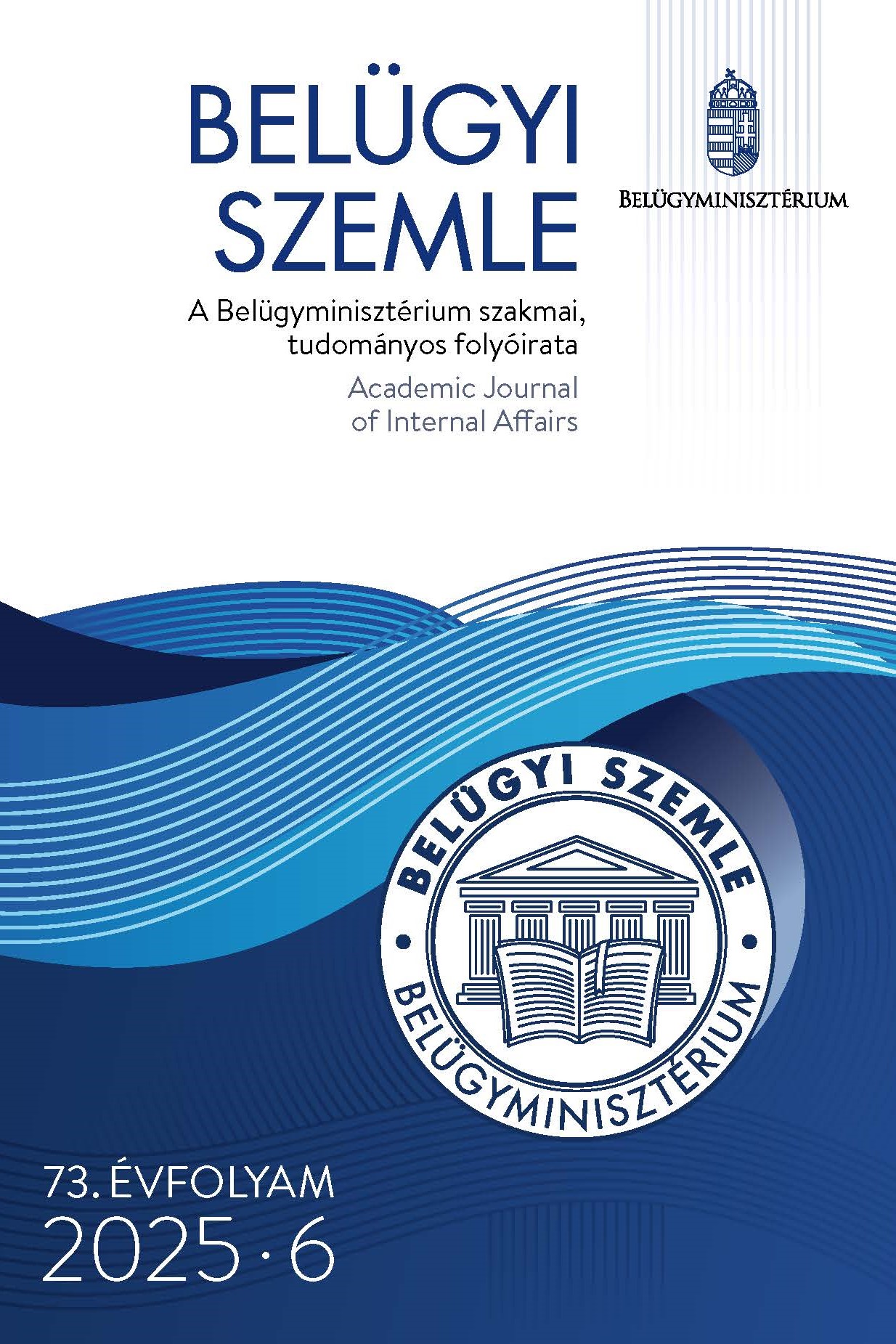Abstract
Aim: The current issue of the International Law Enforcement Observer presents a broad spectrum of topics originating from countries with significantly different socio-economic and cultural contexts. The Republic of South Africa and Azerbaijan represent distinct environments, and the focus areas of the articles are similarly divergent. Drawing a connection between fear of crime and cannabis legalisation would be difficult and, in this case, was not the editors' intention. Instead, the aim is to draw attention to the diversity of criminological research illustrated by international examples.
Methodology: The issue reflects a wide array of research methodologies. Zsolt Lippai’s study highlights the potential role of private security in addressing domestic violence, in addition to the involvement of public authorities. Gábor Bartus’s review introduces a criminological study that explores manifestations of racial and ethnic bias in the criminal justice system of England and Wales.
Findings: Bíborka Horváth’s article points out that, despite a criminal law framework based on zero tolerance toward drugs, there are arguments advocating a more lenient approach—particularly when supported by medical, public health, and social evidence. Hunor Lehel András’s review, based on Azerbaijani research, demonstrates that international studies often reflect patterns previously observed in Hungary, especially regarding the correlation between fear of crime and victimisation.
Value: Criminologically grounded scientific inquiry can significantly enhance the effectiveness of crime prevention, strengthen personal and property security, reduce prejudice in the administration of justice, and promote a supportive and rehabilitative criminal policy.
References
Artz, L. (2011). Fear of failure? Why victims of domestic violence retract from the criminal justice process. South African Crime Quarterly, 37, 3–10. https://doi.org/10.17159/2413-3108/2011/v0i37a855
Boda J. (Szerk.). (2019). Rendészettudományi szaklexikon. Dialóg Campus.
Button, M. (2014). State regulation concerning civilian private security services and their contribution to crime prevention and community safety. United Nations.
Committee on the Elimination of Discrimination against Women. (2022). Inquiry concerning South Africa conducted under Article 8 of the Optional Protocol to the Convention. United Nations.
Cools, S., & Kotsadam, A. (2017). Resources and intimate partner violence in sub-Saharan Africa. World Development, 95, 211–230. https://doi.org/10.1016/j.worlddev.2017.02.027
Goodenough, C. (2007). Joining forces against crime: Potential for the private security industry to become proactive. South African Crime Quarterly, 20, 5–12. https://doi.org/10.17159/2413-3108/2007/v0i20a973
Harrison, O. (2021). The long-term effects of domestic violence on children. Children’s Legal Rights Journal, 41(1), 63–67. https://lawecommons.luc.edu/clrj/vol41/iss1/7
Herman, J. L. (2015). Trauma and recovery: The aftermath of violence – From domestic abuse to political terror. Basic Books.
Hofmann, R. (2023). The ‘total-legalization’ of cannabis in Germany: Legal challenges and the EU free market conundrum. European Journal of Crime, Criminal Law and Criminal Justice, 31(2), 173–196. https://doi.org/10.1163/15718174-bja10044
Kholofelo, A. R., & Tirivangasi, H. M. (2022). Police capacity building in dealing with domestic violence cases in South Africa: An entry point to women’s access to justice. In E. C. Lubaale & A. Budoo-Scholtz (Eds.), Violence against women and criminal justice in Africa (pp. 123–147). Springer Nature. https://doi.org/10.1007/978-3-030-75949-0_5
Központi Statisztikai Hivatal. (n.d.). Regisztrált sértettek, sértetté válások adatai. https://www.ksh.hu/stadat_files/iga/hu/iga0005.html
Lawson, J. (2012). Sociological theories of intimate partner violence. Journal of Human Behavior in the Social Environment, 22(5), 572–590. https://doi.org/10.1080/10911359.2011.598748
Mathews, S., & Abrahams, N. (2001). Combining stories and numbers: An analysis of the impact of the Domestic Violence Act (No. 116 of 1998) on women. Gender Advocacy Programme & Medical Research Council.
Minnaar, A. (2004). Crime prevention, partnership policing and the growth of private security: The South African experience. In G. Meško, M. Pagon & B. Dobovšek (Eds.), Policing in Central and Eastern Europe – Dilemmas of Contemporary Criminal Justice (pp. 23–25). Faculty of Criminal Justice, University of Maribor. https://www.ojp.gov/pdffiles1/nij/Mesko/207977.pdf
Molebeleli, L. B. (2018). A cooperative government approach to domestic violence: The case of SAPS, Ikageng and the North West Department of Justice and Constitutional Development (Master's dissertation). North-West University, South Africa.
Mshweshwe, L. (2020). Understanding domestic violence: Masculinity, culture, traditions. Heliyon, 6(10), e05334. https://doi.org/10.1016/j.heliyon.2020.e05334
Murphy-Oikonen, J., McQueen, K., Miller, A., Chambers, L. & Hiebert, A. (2022). Unfounded sexual assault: Women’s experiences of not being believed by the police. Journal of Interpersonal Violence, 37(11–12), 8916–8940. https://doi.org/10.1177/0886260520978190
Oeschger, S., Nunlall-Hiralal, R. & Steyn, F. (2024). Disrupting gender-based violence: The role of private security. Community Psychology in Global Perspective, 10(1/2), 137–156.
Pingley, T. (2017). The impact of witnessing domestic violence on children: A systematic review (Master's dissertation). St. Catherine University, Minnesota.
Private Security Industry Regulatory Authority. (2023). Annual performance plan 2023/24. https://www.psira.co.za/dmdocuments/PSiRA%20-%20Annual%20Performance%20Plan%202023-24%20Final_new.pdf
Snodgrass, L. (2016). The sins of the father: Gender-based violence in post-apartheid South Africa. Commonwealth Youth and Development, 14(2), 57–70. https://doi.org/10.25159/1727-7140/1798
South African Police Services. (2022). Speaking notes developed by Police Minister General Bheki Cele (MP) at the release of the quarter two crime statistics 2022/2023. https://www.gov.za/news/speeches/minister-general-bheki-cele-quarter-two-crime-statistics-202223-23-nov-2022
Speranza, A. M., Farina, B., Bossa, C., Fortunato, A., Vergano, C. M., Palmiero, L., Quintigliano, M., & Liotti, M. (2022). The role of complex trauma and attachment patterns in intimate partner violence. Frontiers in Psychology, 12, 769584. https://doi.org/10.3389/fpsyg.2021.769584
Troisi, G., & Cesàro, A. N. (2021). Post-traumatic affects and intimate partner violence: An interpretative phenomenological analysis. Mediterranean Journal of Clinical Psychology, 9(1), 1–20.
Veiga, A., Pina-Sánchez, J., & Lewis, S. (2023). Racial and ethnic disparities in sentencing: What do we know, and where should we go? The Howard Journal of Crime and Justice, 62(2), 167–182. https://doi.org/10.1111/hojo.12496
Wantenaar, A. A., & Govender, D. (2023). Experiences of community police forum members in liaison with SAPS, private security, and community members regarding community policing. African Security Review, 32(4), 458–472. https://doi.org/10.1080/10246029.2023.2248095

This work is licensed under a Creative Commons Attribution-NonCommercial-NoDerivatives 4.0 International License.
Copyright (c) 2025 Academic Journal of Internal Affairs

